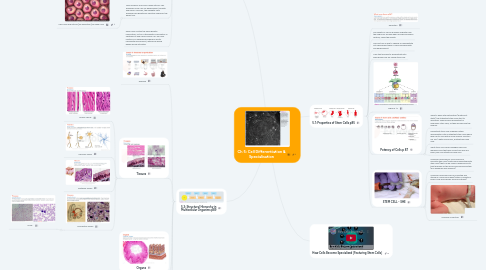
1. 5.2: Stem Cell Differentiation p 88
1.1. Stem Cells
1.2. The Nature of Stem Cells
1.3. Renewal/Differentiation
1.4. Cells divide by a process called mitosis. This produces more cells for development, growth and repair. Normally, the daughter cells produced are genetically identical copies of the parent cell.
1.4.1. Cell Cycle and Mitosis [3D Animation] on Make a GIF
1.5. While cells contain the same genetic information, not all of the genetic information is switched on and used in every cell. The cell’s location in a developing organism and its immediate environment, determine which genes will be activated.
2. 5.3: Structural Hierarchy in Multicellular Organims p89
2.1. Example
2.2. Tissues
2.2.1. Muscle Tissue
2.2.2. Nervous Tissue
2.2.3. Epithelial Tissue
2.2.4. Connective Tissue
2.2.4.1. More...
2.3. Organs
2.4. Systems
2.5. Hypothetical Organism
3. 5.1: Properties of Stem Cells p85
3.1. Definition
3.2. The variety of cells in humans originate from the single cell formed when an egg and sperm fertilise, called the zygote.
3.3. This first cell is able to change or differentiate into specialised types of cells during growth and development.
3.4. Cells that are able to differentiate into specialised cells are called stem cells.
3.5. Figure 5.1.2
3.6. Potency of Cells p 87
3.6.1. About 5 days after fertilisation (blastocyst state), the totipotent stem cells start to specialise. They become pluripotent or embryonic stem cells, as they will become the embryo.
3.6.2. Pluripotent stem cells undergo further specialisation into multipotent stem cells which give rise to cells with a more specific function e.g. red / white blood cells, platelets and skin cells.
3.6.3. Adult stem cells repair damaged cells and replenish cells that have a short life span e.g blood, skin and intestinal lining cells.
3.7. STEM CELL - SHE
3.7.1. Umbilical cord blood is a rich source of neonatal stem cells (particularly haematopoietic stem cells) that can be used in research and to treat diseases of the blood and immune system (e.g. leukaemia and anaemia).
3.7.2. Umbilical cord blood can be collected and stored in a cord blood bank (either in private or public cord blood banks around Australia).
3.7.3. Umbilical Collection
